| Regions of Italy Regioni d'Italia (Italian) | |
|---|---|
| |
 Apulia
Basilicata
Calabria
Sicily
Molise
Campania
Abruzzo
Lazio
Umbria
Marche
Tuscany
Sardinia
Emilia-Romagna
Liguria
Piedmont
Friuli-
Apulia
Basilicata
Calabria
Sicily
Molise
Campania
Abruzzo
Lazio
Umbria
Marche
Tuscany
Sardinia
Emilia-Romagna
Liguria
Piedmont
Friuli-Venezia Giulia Aosta Valley Trentino- Alto Adige Veneto Lombardy Adriatic Sea Ionian Sea Mediterranean Sea Tyrrhenian Sea Ligurian Sea | |
| Category | Regionalised unitary state |
| Location | Italian Republic |
| Number | 20 |
| Populations | 143,000 (Aosta Valley) – 10,342,000 (Lombardy) |
| Areas | 3,261 km (1,259 sq mi) (Aosta Valley) – 25,832 km (9,974 sq mi) (Sicily) |
| Government |
|
| Subdivisions | |
The regions of Italy (Italian: regioni d'Italia) are the first-level administrative divisions of the Italian Republic, constituting its second NUTS administrative level. There are twenty regions, five of which are autonomous regions with special status. Under the Constitution of Italy, each region is an autonomous entity with defined powers. With the exception of the Aosta Valley (since 1945), each region is divided into a number of provinces.
History
During the Kingdom of Italy, regions were mere statistical districts of the central state. Under the Republic, they were granted a measure of political autonomy by the 1948 Italian Constitution. The original draft list comprised the Salento region (which was eventually included in Apulia); Friuli and Venezia Giulia were separate regions, and Basilicata was named Lucania. Abruzzo and Molise were identified as separate regions in the first draft, but were later merged into Abruzzi e Molise in the final constitution of 1948, before being separated in 1963.
Implementation of regional autonomy was postponed until the first Regional elections of 1970. The ruling Christian Democracy party did not want the opposition Italian Communist Party to gain power in the regions where it was historically rooted (the red belt of Emilia-Romagna, Tuscany, Umbria and the Marches).
Regions acquired a significant level of autonomy following a constitutional reform in 2001 (brought about by a centre-left government and confirmed by popular referendum), which granted them residual policy competence. A further federalist reform was proposed by the regionalist party Lega Nord and in 2005, the centre-right government led by Silvio Berlusconi proposed a new reform that would have greatly increased the power of regions.
The proposals, which had been particularly associated with Lega Nord, and seen by some as leading the way to a federal state, were rejected in the 2006 Italian constitutional referendum by 61.7% "no" to 38.3% "yes". The results varied considerably among the regions, ranging from 55.3% in favour in Veneto to 82% against in Calabria.
Political control
See also: Conference of Regions and Autonomous Provinces
Number of regions governed by each coalition since 1995:
Centre-left Centre-right Others
Regions
| Flag | Region Italian name (if different) |
Status | Population January 2023 |
Area | Pop. density (p/km) |
HDI 2022 | Capital | President | Number of comuni | Prov. or metrop. cities | |||
|---|---|---|---|---|---|---|---|---|---|---|---|---|---|
| Number | % | km | % | ||||||||||
| Abruzzo | Ordinary | 1,307,000 | 2.16% | 10,832 km (4,182 sq mi) | 3.59% | 118 | 0.889 | L'Aquila | Marco Marsilio Brothers of Italy |
305 | 4 | ||
| Aosta Valley Valle d'Aosta |
Autonomous | 143,000 | 0.21% | 3,261 km (1,259 sq mi) | 1.08% | 38 | 0.887 | Aosta | Renzo Testolin Valdostan Union |
74 | 1 | ||
| Apulia Puglia |
Ordinary | 3,945,000 | 6.63% | 19,541 km (7,545 sq mi) | 6.48% | 200 | 0.854 | Bari | Michele Emiliano Democratic Party |
257 | 6 | ||
| Basilicata | Ordinary | 559,000 | 0.92% | 10,073 km (3,889 sq mi) | 3.34% | 54 | 0.862 | Potenza | Vito Bardi Forza Italia |
131 | 2 | ||
| Calabria | Ordinary | 1,870,000 | 3.13% | 15,222 km (5,877 sq mi) | 5.04% | 121 | 0.845 | Catanzaro | Roberto Occhiuto Forza Italia |
404 | 5 | ||
| Campania | Ordinary | 5,615,000 | 9.48% | 13,671 km (5,278 sq mi) | 4.53% | 409 | 0.854 | Naples | Vincenzo De Luca Democratic Party |
550 | 5 | ||
| Emilia-Romagna | Ordinary | 4,452,000 | 7.51% | 22,453 km (8,669 sq mi) | 7.44% | 197 | 0.921 | Bologna | Michele De Pascale Democratic Party |
330 | 9 | ||
| Friuli-Venezia Giulia Furlanija-Julijska Krajina/Friûl-Vignesie Julie |
Autonomous | 1,219,000 | 2.03% | 7,924 km (3,059 sq mi) | 2.63% | 151 | 0.903 | Trieste | Massimiliano Fedriga League |
215 | 4 | ||
| Lazio | Ordinary | 5,745,000 | 9.69% | 17,232 km (6,653 sq mi) | 5.71% | 332 | 0.914 | Rome | Francesco Rocca Independent |
378 | 5 | ||
| Liguria | Ordinary | 1,535,000 | 2.56% | 5,416 km (2,091 sq mi) | 1.79% | 278 | 0.898 | Genoa | Marco Bucci Independent |
234 | 4 | ||
| Lombardy Lombardia |
Ordinary | 10,342,000 | 16.89% | 23,864 km (9,214 sq mi) | 7.91% | 418 | 0.912 | Milan | Attilio Fontana League |
1,506 | 12 | ||
| Marche | Ordinary | 1,524,000 | 2.53% | 9,401 km (3,630 sq mi) | 3.12% | 158 | 0.901 | Ancona | Francesco Acquaroli Brothers of Italy |
225 | 5 | ||
| Molise | Ordinary | 324,000 | 0.49% | 4,461 km (1,722 sq mi) | 1.48% | 65 | 0.872 | Campobasso | Francesco Roberti Forza Italia |
136 | 2 | ||
| Piedmont Piemonte |
Ordinary | 4,302,000 | 7.21% | 25,387 km (9,802 sq mi) | 8.41% | 168 | 0.898 | Turin | Alberto Cirio Forza Italia |
1,181 | 8 | ||
| Sardinia Sardegna |
Autonomous | 1,604,000 | 2.68% | 24,100 km (9,300 sq mi) | 7.99% | 66 | 0.868 | Cagliari | Alessandra Todde Five Star Movement |
377 | 5 | ||
| Sicily Sicilia |
Autonomous | 4,825,000 | 8.14% | 25,832 km (9,974 sq mi) | 8.56% | 186 | 0.845 | Palermo | Renato Schifani Forza Italia |
391 | 9 | ||
| Trentino-South Tyrol Trentino-Alto Adige/Südtirol |
Autonomous | 1,111,000 | 1.83% | 13,606 km (5,253 sq mi) | 4.51% | 79 | Trentino: 0.920 | Trento | Maurizio Fugatti League |
282 | 2 | ||
| South Tyrol: 0.910 | |||||||||||||
| Tuscany Toscana |
Ordinary | 3,698,000 | 6.23% | 22,987 km (8,875 sq mi) | 7.62% | 160 | 0.907 | Florence | Eugenio Giani Democratic Party |
273 | 10 | ||
| Umbria | Ordinary | 930,000 | 1.46% | 8,464 km (3,268 sq mi) | 2.81% | 102 | 0.897 | Perugia | Stefania Proietti Independent |
92 | 2 | ||
| Veneto | Ordinary | 4,883,000 | 8.23% | 18,345 km (7,083 sq mi) | 5.97% | 265 | 0.900 | Venice | Luca Zaia League |
563 | 7 | ||
| Italy Italia |
— | 59,933,000 | 100.00% | 302,068.26 km (116,629.21 sq mi) | 100.00% | 195 | 0.892 | Rome | Sergio Mattarella Independent |
7,904 | 107 | ||
Macroregions
Macroregions are the first-level NUTS of the European Union.
| Map | Macroregion Italian name |
Regions | Major city | Population January 2022 |
Area (km) | Population density (km) |
MEPs | ||
|---|---|---|---|---|---|---|---|---|---|
| Number | % | km | % | ||||||
 |
Centre Centro |
Lazio Marche Tuscany Umbria |
Rome | 11,740,836 | 19.91% | 58,085 km (22,427 sq mi) | 19.23% | 202 | 15 |
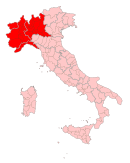 |
North-West Nord-Ovest |
Aosta Valley Liguria Lombardy Piedmont |
Milan | 15,848,100 | 26.87% | 57,928 km (22,366 sq mi) | 19.18% | 274 | 20 |
 |
North-East Nord-Est |
Emilia-Romagna Friuli-Venezia Giulia Trentino-South Tyrol Veneto |
Bologna | 11,561,676 | 19.60% | 62,003 km (23,939 sq mi) | 20.63% | 186 | 15 |
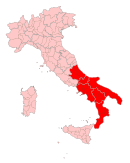 |
South Sud |
Abruzzo Apulia Basilicata Calabria Campania Molise |
Naples | 13,451,861 | 22.81% | 73,800 km (28,500 sq mi) | 24.43% | 182 | 18 |
 |
Islands Isole or Insulare (adj) |
Sardinia Sicily |
Palermo | 6,380,649 | 10.82% | 49,932 km (19,279 sq mi) | 16.53% | 128 | 8 |
Status
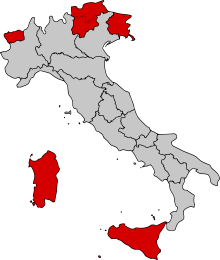
Every region has a statute that serves as a regional constitution, determining the form of government and the fundamental principles of the organization and the functioning of the region, as prescribed by the Constitution of Italy (Article 123). Although all the regions except Tuscany define themselves in various ways as an "autonomous Region" in the first article of their Statutes, fifteen regions have ordinary statutes and five have special statutes, granting them extended autonomy.
Regions with ordinary statute
These regions, whose statutes are approved by their regional councils, were created in 1970, even though the Italian Constitution dates back to 1948. Since the constitutional reform of 2001 they have had residual legislative powers: the regions have exclusive legislative power with respect to any matters not expressly reserved to state law (Article 117). Yet their financial autonomy is quite modest: they keep just 20% of all levied taxes, mostly used to finance the region-based healthcare system.
Autonomous regions with special statute
Article 116 of the Italian Constitution grants home rule to five regions, namely the Aosta Valley, Friuli-Venezia Giulia, Sardinia, Sicily, and Trentino-Alto Adige/Südtirol, allowing them some legislative, administrative and financial power to a varying extent, depending on their specific statute. These regions became autonomous in order to take into account cultural differences and protect linguistic minorities. Moreover, the government wanted to prevent them from potentially seceding or being taken away from Italy after the defeat in World War II.
Institutions
Each region has an elected parliament, called Consiglio Regionale (regional council), or Assemblea Regionale (regional assembly) in Sicily, and a government called Giunta Regionale (regional committee), headed by a governor called Presidente della Giunta Regionale (president of the regional committee) or Presidente della Regione (regional president). The latter is directly elected by the citizens of each region, with the exceptions of Aosta Valley and Trentino-Alto Adige/Südtirol regions where the president is chosen by the regional council.
Under the 1995 electoral law, the winning coalition receives an absolute majority of seats on the council. The president chairs the giunta, and nominates or dismisses its members, called assessori. If the directly elected president resigns, new elections are called immediately.
In the Trentino-Alto Adige/Südtirol region, the regional council is made up of the joint session of the two provincial councils of Trentino and of South Tyrol. The regional president is one of the two provincial commissioners.
Representation in the Senate
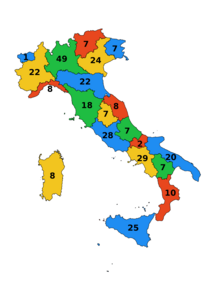
Article 57 of the Constitution of Italy originally established that the Senate of the Republic was to be elected on a regional basis by Italian citizens aged 25 or older (unlike the Chamber of the Deputies, which was elected on a national basis and by all Italian citizens aged 18 or older). No region could have less than 7 senators, except for the two smallest regions: Aosta Valley (1 senator) and Molise (2 senators). From 2006 to 2020, 6 out of 315 senators (and 12 out of 630 deputies) were elected by Italians residing abroad.
After two constitutional amendments were passed respectively in 2020 (by constitutional referendum) and 2021, however, there have been changes. The Senate is still elected on a regional basis, but the number of senators was reduced from 315 to 200, who are now elected by all citizens aged 18 or older, just like deputies (themselves being reduced from 630 to 400). Italians residing abroad now elect 4 senators (and 8 deputies).
The remaining 196 senators are assigned to each region proportionally according to their population. The amended Article 57 of the Constitution provides that no region can have fewer than 3 senators representing it, barring Aosta Valley and Molise, which retained 1 and 2 senators respectively.
| Region | Seats | Region | Seats | Region | Seats |
|---|---|---|---|---|---|
| 4 | 4 | 5 | |||
| 1 | 18 | 16 | |||
| 13 | 5 | 6 | |||
| 3 | 31 | 12 | |||
| 6 | 5 | 3 | |||
| 18 | 2 | 16 | |||
| 14 | 14 | Overseas constituencies | 4 |
Economy of regions and macroregions
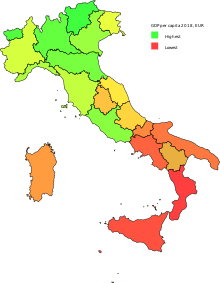
| Flag | Name | GDP 2018, million EUR |
GDP per capita 2018, EUR |
GDP 2011, million PPS |
GDP per capita 2011, PPS |
|---|---|---|---|---|---|
| Abruzzo | 33,900 | 25,800 | 29,438 | 21,900 | |
| Aosta Valley | 4,900 | 38,900 | 4,236 | 33,000 | |
| Apulia | 76,600 | 19,000 | 68,496 | 16,700 | |
| Basilicata | 12,600 | 22,200 | 10,517 | 17,900 | |
| Calabria | 33,300 | 17,000 | 32,357 | 16,100 | |
| Campania | 108,000 | 18,600 | 91,658 | 15,700 | |
| Emilia-Romagna | 161,000 | 36,200 | 139,597 | 31,400 | |
| Friuli-Venezia Giulia | 38,000 | 31,200 | 35,855 | 29,000 | |
| Lazio | 198,000 | 33,600 | 168,609 | 29,300 | |
| Liguria | 49,900 | 32,100 | 43,069 | 26,700 | |
| Lombardy | 388,800 | 38,600 | 330,042 | 33,200 | |
| Marche | 43,200 | 28,300 | 40,014 | 25,500 | |
| Molise | 6,500 | 20,900 | 6,278 | 19,700 | |
| Piedmont | 137,000 | 31,500 | 123,336 | 27,600 | |
| Sardinia | 34,900 | 21,200 | 32,377 | 19,300 | |
| Sicily | 89,200 | 17,800 | 82,183 | 16,300 | |
| Trentino-Alto Adige/Südtirol | 41,700 | 39,200 | 35,041 | 33,700 | |
| Tuscany | 118,000 | 31,500 | 103,775 | 27,600 | |
| Umbria | 22,500 | 25,400 | 21,078 | 23,200 | |
| Veneto | 163,000 | 33,200 | 146,369 | 29,600 |
| Code | Name | GDP 2011, million EUR |
GDP per capita 2011, EUR |
GDP 2011, million PPS |
GDP per capita 2011, PPS |
|---|---|---|---|---|---|
| ITE | Centre | 340,669 | 28,400 | 333,475 | 27,800 |
| ITC | North-West | 511,484 | 31,700 | 500,683 | 31,000 |
| ITD | North-East | 364,560 | 31,200 | 356,862 | 30,600 |
| ITF | South | 243,895 | 17,200 | 238,744 | 16,800 |
| ITG | Islands | 117,031 | 17,400 | 114,560 | 17,000 |
| - | Extra-regio | 2,771 | – | 2,712 | – |
See also
- Italian NUTS level 1 regions
- Regional council (Italy)
- List of current presidents of regions of Italy
- List of Italian regions by GDP
- List of Italian regions by GRP per capita
- List of Italian regions by Human Development Index
- Flags of regions of Italy
- ISO 3166-2:IT
Other administrative divisions
References
- "National structures". Eurostat. Archived from the original on 13 July 2014. Retrieved 6 December 2011.
- ^ "Speciale Referendum 2006". la Repubblica. 26 June 2006. Retrieved 6 December 2011.
- "Population Italian Regions". tuttitalia.it.
- "Sub-national HDI – Area Database – Global Data Lab". hdi.globaldatalab.org.
- "Italian Comuni". tuttitalia.it.
- "ISTAT geo-demo".
- Torrente, Luciano; Strazzullo, Paolo; Pinto, Roberto. "Statuti Regionali – Casa Editrice: Edizioni Simone". www.simone.it. Archived from the original on 19 February 2018. Retrieved 6 June 2011.
- LL.M., Prof. Dr. Axel Tschentscher. "ICL – Italy – Constitution". servat.unibe.ch.
- Report RAI – Le regioni a statuto speciale (Italian), retrieved 21 January 2009 Archived 22 March 2009 at the Wayback Machine, Archived 6 October 2008 at the Wayback Machine
- Hiroko Kudo, "Autonomy and Managerial Innovation in Italian Regions after Constitutional Reform", Chuo University, Faculty of Law and Graduate School of Public Policy (2008): p. 1. Retrieved on 6 April 2012 from http://www.med-eu.org/proceedings/MED1/Kudo.pdf Archived 17 November 2015 at the Wayback Machine.
- ^ "GDP per capita in the EU in 2011" (PDF). Archived from the original (PDF) on 7 March 2014.
External links
- CityMayors article
- Regional Governments of Italy on Italia.gov.it
- Regional Governments of Italy on Governo.it
| Regions of Italy | |||||
|---|---|---|---|---|---|
| Central | |||||
| Northern Italy |
| ||||
| Southern Italy |
| ||||
| Autonomous regions | |||||
| Regions of Europe | |
|---|---|
| Sovereign states |
|
| States with limited recognition | |
| Dependencies and other entities | |
| First-level administrative divisions in European countries | |
|---|---|
| Sovereign states |
|
| States with limited recognition | |
Table of administrative divisions by country
| |